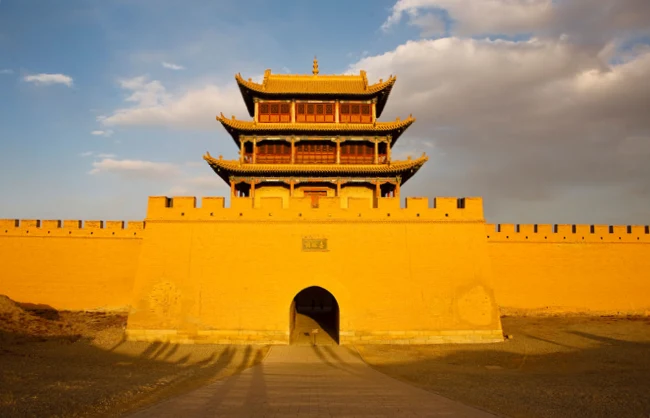Written by Veronica |
Jiayuguan Fort is located in the middle of a valley, 5 km west of Jiayuguan City, Gansu Province, China. As the western starting point of the Great Wall in the Ming Dynasty, Jiayuguan Fort is known as the “Greatest Pass under Heaven”. It was built in the Ming Dynasty in 1372 and has a history of more than 600 years.
Jiayuguan Fort was not only an important pass for military defense but also an important traffic fortress on the ancient Silk Road. Jiayuguan Fort, with its steep terrain, was an important defense line for the ancient dynasties living in the Central Plains against the invasion of nomads in the northwest.
Jiayuguan Fort Fatcs
- Location: Intersection of South Guancheng Road and Shuangyong Road, Yuquan Town, Jiayuguan City, Gansu Province
- Ticket Price: 110 yuan/person (May 1stto October 31th); 90 yuan/person (November 1st to April 30th)
- Opening Time: 8:00-18:20 (matinee ticket); 20:00-24:00 (evening ticket)
- Best Visiting Time: May to October

Overview of the Great Wall at Jiayuguan Fort
After the opening of the Silk Road in the Han Dynasty, Hexi Corridor became an important political, economic and military gateway between the central Chinese dynasties and the tribes of central Asia. After the collapse of the Yuan Dynasty in 1368, its remnants fled to the Hexi Corridor and areas to the west, posing a great and lasting threat to the Ming Dynasty.
Therefore, Feng Sheng was appointed to lead an army to the west to conquer the remnants of the Yuan Dynasty and recover the occupied areas of Hexi Corridor. On his way back, Feng Sheng selected a strategic place that could be used for both offensive and defensive purposes and began to build Jiayuguan Pass.
After four dynasties of construction, it was not until 1539 that Jiayuguan Fort finally became a complete comprehensive defense base.
What to See in Jiayuguan Fort
Jiayuguan Fort consists of five parts: inner city, outer city, Weng city, Luo city and moat, with a total length of about 60 kilometers. Jiayuguan Pass traverses Gobi desert and connects the Overhanging Great Wall of the Black Mountain to the north, and the Qilian Mountains to the south, forming a strong military defense system.
Jiayuguan Pass
It is one of the most complete ancient military buildings in China. Jiayuguan Fort is square in shape, with a city gate and a turret on each side. On the east and west sides are an enemy tower and an archery tower. There are offices, post stations, barracks, granaries, and other facilities. Ascend to the top of Jiayuguan Pass and overlook the vast Gobi desert, you can feel the vicissitudes of history and greatness.

The Great Wall Museum
Located at the foot of Jiayuguan Pass, the Great Wall Museum houses many precious cultural relics such as the Great Wall plates, bows and arrows, iron armor, wall paintings, and bricks. These ancient weapons, armor, drums and other military supplies bear witness to the bravery of the soldiers in defending the country.
The First Pier of the Great Wall
The first pier of the Great Wall, is also known as the Taolaihe pier. It is the southernmost pier of the Western Great Wall of Jiayuguan, and also the westernmost pier of the Great Wall of the Ming Dynasty. With its steep terrain and spectacular natural scenery, this is the perfect place for sightseeing and reminiscing about history.

How to Get to Jiayuguan Fort
By Self-driving: You can drive along the Lanxin Expressway to the Jiayuguan Exit, then follow National Highway 312 west for about 3 kilometers to the Jiayuguan Scenic parking lot. The parking fee is 10 yuan/time.
By Bus: In the Jiayuguan city center, you can take the direct bus such as No. 1, No. 4, No. 5, No. 6, and No. 7, to the Jiayuguan Fort scenic area. It costs 1 yuan/person.
By Taxi: You can take a taxi from Jiayuguan City to Jiayuguan Fort scenic area for about 15 minutes, and the fare is about 15 yuan.
Attractions nearby Jiayuguan Fort
- Weijin Tombs: There are more than 1,400 brick tombs from the Wei and Jin dynasties, and they are hailed as “the largest underground art museum in China”.
- Mogao Caves: Boasting 735 caves in Mogao Caves, it preserves more than 45,000 square meters of murals. It is a microcosm of the development of Chinese grotto art and is also known as one of the three major grottoes in China.
- Overhanging Great Wall: It snakes up the mountain, and parts of it are almost perpendicular to the ground as if suspended in mid-air. Hence it was named Overhanging Great Wall.









